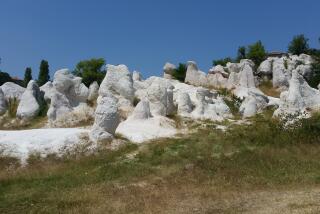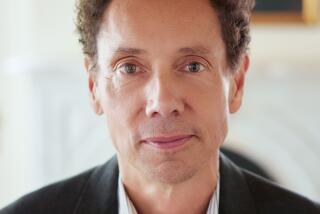Book Review : Oddly Dense Matter From a Keen Mind
- Share via
Time’s Arrow, Time’s Cycle: Myth and Metaphor in the Discovery of Geological Time by Stephen Jay Gould (Harvard: $17.50; 219 pp.)
Stephen Jay Gould is one of our foremost expositors of science, a man of extraordinary intellect and knowledge and an uncanny ability to blend the two. He sees familiar things in fresh ways, and his original thoughts are textured with meaning and powerfully honed.
So the publication of a new book by Gould is a cause for celebration.
The question is not whether a book by Gould is good, but how good? “Time’s Arrow, Time’s Cycle” is a fascinating, challenging and provocative book, but it is not as good as it should be. Gould has written another fine book, but it is not up to the level of his earlier books.
To begin with, there is the curious title, which perhaps says more about the book than Gould intended. “Time’s Arrow, Time’s Cycle: Myth and Metaphor in the Discovery of Geological Time.” What in the world does that mean?
Brilliant Message, But . . .
It is a question readers may ask themselves repeatedly. For Gould’s prose, normally crystal-clear, here tends toward the dense. He is so eager to cram every bit of meaning into each sentence that the sentences sometimes get weighted down with embedded thoughts. The same may be said for the overall structure, which is rich in meaning but somewhat convoluted.
Gould’s message is brilliant as usual. It turns out that the “time’s arrow” and “time’s cycle” of the title are the two ways that people view history: as a sequence of events, a directed march from here to there (the arrow), or as a pattern of recurring events (the cycle).
Gould argues that history is an arrow and a cycle, inextricably interwoven. There is a recurring pattern, but it is always different. Today’s date, printed on this page, illustrates both aspects of time. Each year comes just once, but the month and date recur in a regular cycle.
There is a Zen principle that says there are big truths and small truths, and the way you tell the difference is this: The denial of a small truth is clearly false, but the denial of a big truth is also true.
‘Must Have Both’
To Gould, time’s arrow and time’s cycle are big truths.
“Time’s arrow is the intelligibility of distinct and irreversible events, while time’s cycle is the intelligibility of timeless order and lawlike structure,” Gould writes. “We must have both.”
He then uses this insight to present a radically revisionist look at the history of geology in the 17th, 18th and 19th centuries by re-examining the works of the three giants in the field, Thomas Burnet, James Hutton and Charles Lyell.
In each case, Gould’s close textual analysis challenges the orthodox view of these three men. Burnet was not the foolish religionist that he is usually portrayed to be, and Hutton and Lyell were not the champions of the scientific method and architects of modern geology, as they are normally caricatured.
Rather, Gould says, each of these men is best understood through his relation to the sequential or cyclic versions of time. (Readers interested in pursuing this idea should turn to the book. The argument is too rich to be briefly summarized.)
Pioneering Scientists
Hutton was the first to discover what Gould calls “deep time” or geological time, the fact that the world has existed not for a few thousand years, as the Bible implies, but for an incomprehensibly long time, measured in billions, not thousands.
Gould ranks this insight with Copernicus’s discovery of the model of the solar system and Darwin’s discovery of evolution in its power to rearrange humanity’s view of itself.
Gould, a master historian of science as well as a master scientist, also spins out a theory of science while he is spinning out all the rest. His history of the origins of geology is a case study of the role of metaphor and vision in science, “the passion of science as a struggle of ideas, not only a compendium of information,” he writes.
Gould wants to puncture the standard textbook versions of many things, not just of what Burnet, Hutton and Lyell meant in the history of geology, but also of how science itself is done. For Gould, facts are inseparable from theories, and the whole kit and caboodle is a human enterprise. People are the active creators of science, not its passive recipients.
Synthesizer of Ideas
Gould acknowledges that much of what he has to say is not altogether new with him. He is a terrific synthesizer along with everything else. But there are plenty of new thoughts, which he combines with other people’s ideas in interesting new ways.
The trouble is that only geologists will have the will or stamina to follow the details of Gould’s discussion. His popular writing in Natural History magazine is usually so good that it is odd that he has abandoned that successful style in this book.
Gould’s thoughts and insights are so inspired that it is worth slogging through “Time’s Arrow, Time’s Cycle” just to be in his presence.
But he needn’t have made it such a chore, and his ideas would find a wider audience if he had run sections of it through the typewriter one more time.
More to Read
Sign up for our Book Club newsletter
Get the latest news, events and more from the Los Angeles Times Book Club, and help us get L.A. reading and talking.
You may occasionally receive promotional content from the Los Angeles Times.









